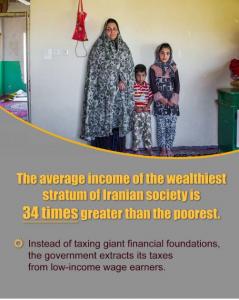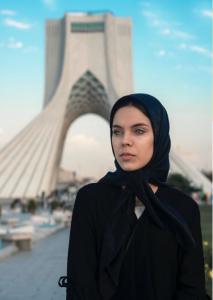(Video) The Effects of Extreme Poverty on the Body and Soul of Iranian Women
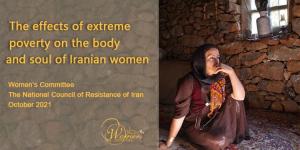
(NCRI) and (PMOI / MEK Iran): For this reason, with a brief look at the spread of poverty in Iran and its “feminization,” we focus on this aspect of the human rights violations of the Iranian people by the mullahs’ regime.
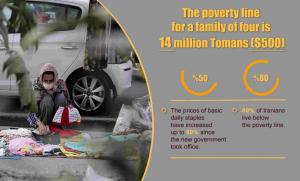
(NCRI) and (PMOI / MEK Iran): According to the official statistics of the Statistics Center of Iran, in spring of 2021, 4.2 million women have been registered as economically active population, which is equivalent to 14.1%.
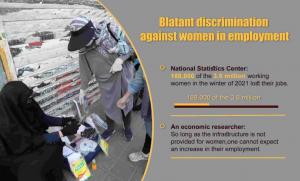
(NCRI) and (PMOI / MEK Iran): According to statistics recorded in government news agencies, 60% of employment in Iran is informal employment. This figure is over 70% in many provinces of the country.
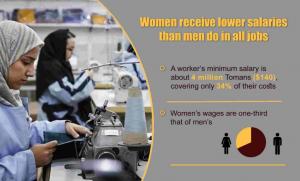
(NCRI) and (PMOI / MEK Iran): Despite the hours of rigorous work per day, many women do not receive any salary at all. In all villages and even in many cities, women carry the main burden of family jobs.
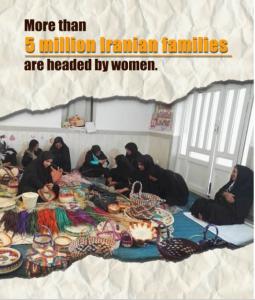
(NCRI) and (PMOI / MEK Iran): "There are no exact statistics on the number of women heads of households in the province, because some of them are not supported by a specific institution," said Somayeh Ghassemi Tussi.
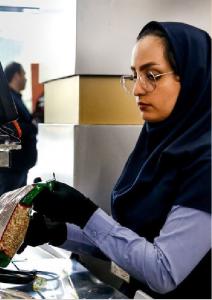
(NCRI) and (PMOI / MEK Iran): despite the family having acquired official permit for the construction. The family had paid 200 million Tomans just to get the permit and then spent another 500 million Tomans to build their house with great difficulty.
A brief look at the spread of extreme poverty in Iran and its “feminization,” as a human rights violation in Iran by the mullahs’ regime.
For this reason, with a brief look at the spread of poverty in Iran and its “feminization,” we focus on this aspect of the human rights violations of the Iranian people by the mullahs’ regime. The gross and brutal manifestations of human rights violations in Iran make poverty a secondary issue. However, the study of the spread of extreme poverty among the Iranian people especially Iranian women can be a strong and sufficient reason for the illegitimacy of the mullahs’ rule over this rich nation.
Even though the information and statistics that have been collected, do not tell the whole story, but since it is entirely extracted from the comments of government officials, experts, and the regime’s own media, it can show the immense human tragedy being unfolded in Iran.
Overview
Only a few months into the formation of Raisi’s government, the upward trend in prices has taken a new momentum. The prices of the items in the basket of consumer goods for people’s daily needs have increased by 10 to 50 percent.[1]
The cost of living in Iran has increased by 32%.[2]
The overall quality of life in general and the lives and livelihoods of deprived women and families, especially in the context of both poverty and the pandemic, has moved the boundaries of disaster. Most people are in dire need of food, housing, medical care, clothing, and necessities of life and their situation is deteriorating by the day.
The coronavirus epidemic has plunged many businesses on the verge of bankruptcy leading to many people losing their jobs and incomes. During this period, many families in Iran are dealing with a decline in their income while facing a significant rise in the price of everyday household items. For example, the price of some food items has risen by 90% and the housing rental has multiplied.
The rising poverty line and rampant inflation in Iran are among the main causes of the phenomenon known as child marriages. About the increment of the poverty line, it can be discussed that “If the poverty line of a family of four in the country at the beginning of this year was estimated to be 12 million Tomans per month, today this line has reached 14 million Tomans per month.” said Mohammad Reza Mahboubfar.[3]
Roozbeh Kordoni, the head of the Higher Institute for Social Security Research, said the number of people below the absolute poverty line in Iran has doubled.[4]
The first report of the Ministry of Labor and Social Welfare of Raisi’s government was published in August 2021. According to the report, the number of people below the poverty line in Iran in 2020 had reached 36 million.[5]
Meanwhile, Shahab Naderi, a member of the parliament in 2017, revealed that 80% of Iranian society lives below the poverty line.[6]
During the last four years with a complete economic collapse, the Iranian regime had no intention and wasn’t capable of improving the people's economic situation. The economic statistics depict a horrifying condition of Iranian society.
The continuation of the mullahs’ rule will lead to a more bleak and dire situation for women in Iran. To survive, women will be compelled to gather the garbage, work as human mules, sell their organs, prostitute themselves and sell their infants amongst all kinds of other calamities.
Women Face Severe inequality in employment
With the spread of extreme poverty in Iran, women face serious inequality in employment.
According to the official statistics of the Statistics Center of Iran, in the spring of 2021, 4.2 million women have been registered as economically active population, which is equivalent to 14.1%. According to the center’s indicators, an economic activist is a person who is employed or looking for a job. In other words, this statistic includes unemployed women looking for a job as well. Meanwhile, housewives, retirees, students, and all those frustrated with finding a job are considered the economically inactive population and are not considered unemployed.
The center estimates the working population of women in the spring of 2021 to be 3.6 million (equivalent to 11.5 percent). This statistic has decreased by 168,000 people compared to the previous year, i.e. the winter of 2020 (1399).[7]
According to the Deputy Minister of Women and Family Affairs statistics in Rouhani’s government, about 15.3% out of 4,320,000 women employed in 2019 lost their jobs in 2020, and the ratio of women to men who lost their jobs in 2020 is 9 times more. According to the report, the unemployment rate of Iranian women is 3 times higher than the global average.[8]
From another report by the Statistics Center of Iran, it can be concluded that the percentage of decline in the number of working women in Iran from fall 2019 to fall 2020, during the first year of the Covid-19 pandemic, was almost 14 times higher than men.[9]
“It is not possible to predict an increase in employment and participation rates for women in 2021,” said Fatemeh Azizkhani, an economic researcher on the prospects for women’s employment. “This anticipation is not reachable until the infrastructure is provided for women.”[10] She added.
The majority of working women are engaged in informal employment
According to statistics recorded in government news agencies, 60% of employment in Iran is informal employment. This figure is over 70% in many provinces of the country. The state-run ILNA news agency estimated the number of women engaged in informal employment at 3 million in March 2020. [11]
Informal occupations are more vulnerable to Coronavirus consequences than formal occupations. [12] These women are among the most vulnerable workers in the Iranian labor market.
Informal employment comes in various forms but all of the women involved face common problems. They do not have insurance; they are deprived of medical services and medical records. They have no benefit from pensions and unemployment insurance, and finally, protection laws and safety and labor laws do not give them coverage. Sometimes, employers exploit these women by taking white-collar checks and promissory notes from them and they have to comply because any job is better than unemployment for these desperate women.
Self-employed women, including peddlers in public and subway spaces, suffer from social and occupational insecurity, such as occasional arrests, and the tightening of employment space.
Women who work in family businesses are forced to submit to any kind of exploitation by their male relatives. [13]
All of these problems have multiplied since the beginning of the Covid-19 pandemic. Declining demand in the service sector has led to the widespread disappearance of these jobs. [14] Since no government agency cares about the safety and health of these women, they have always been alone and fought alone, and now they are alone in the Coronavirus crisis! [15]
Fatemeh Ghafouri, head of the Women Entrepreneurs Association in Qazvin province, says of the clerical regime’s approach to women’s work. She said, “Women advocacy bodies have only focused on family issues and even if they pay attention to the economy, they see everything in household businesses, while this type of job is unsustainable and cannot lead to the empowerment of women in a desirable way.” [16]
What is the income of women in informal employment?
Mahnaz Ghadirzadeh, a labor relations expert, says, “Not only the peddlers we see every day on the subway or on the sidewalks of the city, but also a significant number of female white and blue-collar workers are also unemployed and cannot receive unemployment insurance. We know that many women work by agreement. Secretaries of doctors, service workers, and employees of private offices, etc.; in many cases they are paid less than one million Tomans ($41) and are not insured.” [17]
Tayyebeh Siavoshi, a former member of the regime’s parliament, said, “Unfortunately, many working women are willing to work in any environment, not subject to any law, even for 400,000 to 500,000 Tomans ($16.5 to $20.5) a month due to severe financial needs. Not only they do not enjoy any benefits or facilities, the employer can terminate these workers whenever he wants for any reason.” [18]
Wage discrimination against working women
The clerical regime’s Labor Ministry has set the 2021 minimum wage at 4 million Tomans ($143), including every bonus or possible subsidy. [19]
Workers’ wages cover only 34% of their expenses. This means that a full-time working person who receives their full salary will finish it in the first ten days of the month. More than 14 million Iranian workers are preoccupied with surviving for a single day.” [20]
Working women have to endure the pressures of discriminatory laws and culture dominating the Iranian labor market. Additionally, the reality of women’s working conditions in Iran can only be compared to the conditions akin to slavery.
Mahnaz Ghadirzadeh, a labor relations expert and women’s rights activist, told the state-run ILNA news agency: “Women earn less than men systematically and within the framework of some laws. Women do not get benefits like child support, but apart from that, in some cases we see women being employed in jobs that in many ways do not get the minimum wages. Many female secretaries in offices and most female counter staff suffer from wage discrimination … In traditional jobs or small workshops, we find plenty of women who are paid less than men for the same work.” [21] Most women live on an income of 300,000 to 400,000 Tomans a month. [22]
Qassem Sookhteh-Sarai, head of the Golestan province’s agricultural union, said, “Iranian female farmers earn 60 percent compared to male wages, whether in the paddy fields, summer crops, or market gardening products.” [23] Production costs have risen in the agricultural sector and men do not accept lower wages and refuse to work, but women are in dire need of jobs for a variety of reasons, including poverty, so they are willing to work for much lower wages. Women’s wages are one-third of men’s.
Employers cut women’s salaries by one-third on the pretext that men are responsible for paying their household expenses. This is an injustice to the women heads of households most of whom are daily wage earners and do not have insurance. [24]
Forced labor as a family occupation
Despite the hours of rigorous work per day, many women do not receive any salary at all. In all villages and even in many cities, women carry the main burden of family jobs in addition to all household chores and childcare.
A paddy woman from Rasht, who has three children and has been producing rice in the paddy field with her husband for the past 25 years, told ISNA: “I have been engaged in the patty fields since I was a child and I have never been paid for it.”
“The hard work that paddy women put on their farms is not added to the cost of rice,” said another paddy woman.
“Our men go to coffee shops after harvesting rice, but rural women do not finish their work after harvesting. Besides taking care of household chores, they also must take care of livestock and poultry, and produce handicraft products to sell” said a rice farmer from Fooman.[25]
Mrs. Maryam Rajavi the President-elect of the National Council of Resistance of Iran’s (NCRI): "Poverty has become widespread; starvation has affected millions. Unemployment and loss of jobs have enraged the public. The daily bankruptcy of businesses has destroyed many families. Women and youth are perishing from repression and deprivation.
This is why there is no solution for the multitude of unanswered demands by the people and the outbreak of protests. So, the mullahs will ultimately face the uprisings".
DOWNLOAD THE PDF AND READ THE FULL TEXT
[1] The state-run Hamdeli newspaper, September 19, 2021.
[2] The state-run news agency, June 15, 2021
[3] The state-run ROKNA and ILNA news agencies, August 23, 2021
[4] Radio Farda, June 13, 2021
[5] The poverty line of every Iranian is 1.2 million Tomans; one out of every three Iranians is below the poverty line! – The state-run Tejaratnews website, 31 August 2021
[6] 80% of the Iranian society is below the poverty line the state-run Khane Melat news agency, March 13, 2017
[7] The National Statistics Center of Iran, Abstract of the results of the labor force survey, Spring 2021
[8] The Coronavirus impact on women’s employment 9 times more than men – the official website of the presidential directorate of Women and Family Affairs, May 15, 2021
[9] The Coronavirus impact on women’s employment in Iran; 14 times more than men, BBC Persian site, March 8, 2021
[10] Predicting the status of women’s employment in 2021, Do not wait for job creation!
[11] No one thinks of women during the pandemic; 3 million women earn living in the informal economy, the state-run ILNA news agency, March 8, 2020
[12] The state-run ISNA news agency, June 17, 2020
[13] No one thinks of women during the pandemic; 3 million women earn living in the informal economy, the state-run ILNA news agency, March 8, 2020
[14] The state-run Eghtesadonline.com, June 17, 2020
[15] No one thinks of women during the pandemic; 3 million women earn living in the informal economy, the state-run ILNA news agency, March 8, 2020
[16] The official IRNA news agency, July 13, 2020
[17] The state-run ILNA news agency, April 11, 2020
[18] The official website of the Directorate on Women and Family Affairs, May 1, 2019
[19] The state-run ILNA news agency – June 14, 2021
[20] The state-run Tasnim news agency, September 23, 2020
[21] Wage discrimination against the disabled, women, and children; female workers demand equal wages, the state-run ILNA news agency, October 21, 2020
[22] Here, women earn 10,000 Tomans per day, the state-run ISNA news agency, August 17, 2019
[23] The state-run ILNA, October 22, 2019
[24] The official IRNA news agency, May 3, 2018
[25] Most Gilani rice farmers do not have a salary, the state-run ISNA news agency, April 13, 2015
Tags: PovertyWomen Heads of Household
Shahin Gobadi
NCRI
+33 6 51 65 32 31
email us here
Visit us on social media:
Facebook
Twitter
Message to the virtual conference in the UK on International Women’s Day
Legal Disclaimer:
EIN Presswire provides this news content "as is" without warranty of any kind. We do not accept any responsibility or liability for the accuracy, content, images, videos, licenses, completeness, legality, or reliability of the information contained in this article. If you have any complaints or copyright issues related to this article, kindly contact the author above.

